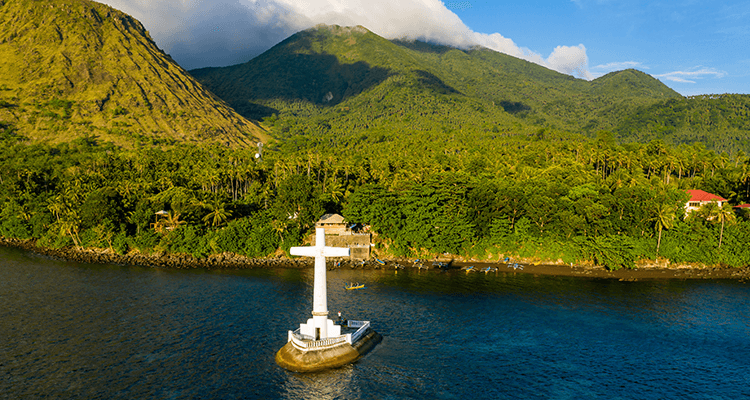
Camiguin is a province in the Northern Mindanao region of the Philippines. It is a pear-shaped island known as the “Island born of fire” which was formed out of volcanic eruptions and land movement. It is a paradise that boasts of having a very diverse ecosystem and well- preserved natural environment. Camiguin’s rustic environment perfectly blends with its pristine and natural scenery. This makes the island an ideal travel destination to those who long for a laid back yet exciting vacation and adventure.

You can do exciting water sports activities like swimming, snorkeling, diving and boat riding since the island abounds in beaches, waterfalls and springs. You can also be treated to a natural fish spa where little fishes nibble at your foot skin while you are in the water. When you do snorkeling in the sunken cemetery, you will see the tombstones underneath the waters. You will also see various species of coral reefs and clams.
If you want to flex your legs muscles, go hiking and trekking. There are trails for hikers leading to the top of the volcanoes. As you ascend, you will be treated to a lush green jungle and massive vegetation. The island is a haven of biodiversity and has preserved its flora and fauna. Take your time and see them in their natural glory while you trek.
You may explore the island at your own pace. With only 237 square kilometers of land, you can easily navigate the entire perimeter and enjoy the spots the province is famous for. You may go for a drive on your own or hire a scooter with a driver. There are areas that are not yet developed for tourists that you can access on your own.
Camiguin has simple and kind locals. Spend time with them and know about their unique heritage. If you happen to be there in October, you can join their annual Lanzones festival. After all, Camiguin is known for producing the sweetest lanzones in the country.
You will see the ruins of a church built during the Spanish colonial period. The remains are a reminder of the series of volcanic eruptions of Mt. Vulcan that happened from 1871 - 1875. The sturdy walls and columns strongly held itself against the eruptions and they remain standing to this day.
The eruption of Mt. Vulcan in 1871 submerged Catarman’s cemetery several meters below the sea. You will see the tombstones under the water. It is a poignant remembrance that the resting place of the dead was not spared from nature’s wrath. A cross was erected in the site in 1982 to mark the place.
The watchtower was built by the Spaniards to guard against the Moros who might attack the island. Moros were pirates who were considered as enemies of the Spaniards and the local inhabitants. This shrine has been preserved but a bit hidden in the premises of an elementary school in the town today.
This pristine and powdery white C-shaped sandbar is 10 minutes away from the northern coast of Camiguin. It’s brazen bareness surprisingly invites you to just spend a tranquil and lazy day and enjoy its “nothingness”. It has Mt Hibok Hibok and Mt Vulcan as backdrop.
Mt. Hibok Hibok is an active volcano. It’s last recorded eruption was in 1953. While it is an active volcano, it can offer you a very good trekking experience. It has an elevation of 1,322 meters above sea level.
Located in Sagay town, it offers you a rejuvenating experience of enjoying the natural, cold spring waters cascading from Mt. Mambajao. The clear water has a temperature of 20ºC and flows into a main pool and a kiddie pool.
This place is located on the mountainside of Mt. Hibok Hibok. You can enjoy the rare experience of indulging in a 40ºC hot spring which comes right out of the forest. Many say that the hot water also offers a therapeutic effect to the weary body.
The most popular among the 3 waterfalls in Camiguin. It is located in Catarman and accessible to anyone. You will be captivated by the powerful flow of the waters that plunges 20 meters to the 2 pools below. It is covered in a dense forest which makes it a hidden paradise to swim in.
Planning to visit Camiguin Island in the next coming days? Checkout the weather in Camiguin Island.




Cagayan de Oro is the gateway to Camiguin. You have to take either Philippine Airlines or Cebu Pacific Air and head to Laguindingan International Airport in Cagayan de Oro.
From the airport or from other areas where one has to travel by land, you have an option to go via either of these 2 ports going to Benoni Wharf in Camiguin.
a. Macabalan Port which has only 1 trip per day.
b. Balingoan Seaport which has almost every hour trip and much cheaper.
You can take a ferry from Cebu to Tagbilaran port in Bohol. Then travel by land to Jagna town. There is a Super Shuttle Ferry that offers RORO service at 1 pm daily. It takes 4 hours to get to Balbagon Port, Mambajao in Camiguin.

No review available.